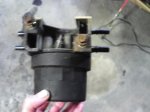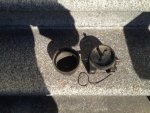joenorthcarolina
Well-Known Member
- Joined
- Jul 28, 2008
- Messages
- 85
- Age
- 48
- Transmission
- Manual
Ok, my truck started spilling fuel from the Fuel Accumulator canister. I guess thats what its called, at least thats what I've read. Any how, I've attached is a example photo of the thing. So, since I've already replaced the in-tank pump with a Walbro 190 and detached the 2nd frame rail pump (filter in its place) I figure I don't need the Accumulator any more. Actually, the Walbro may be what made the accumulator leak  . Now my new problem is I'm not 100% sure which hose is which on the canister. Let me rephrase that, the top of the canister has 3/8" quick connect on one side and a 5/16" quick connect below that one. On the other end of the canister the quick connect nipples are flipped... the 5/16" quick connect is on the top and the 3/8" quick connect is on the bottom. That being said, does the canister reduce the hose or does it just seem that way ? In other words, when I install the adapter of some sort do I buy a 3/8" to 5/16" reducer quick connect or a straight 3/8" to 3/8" tube ?
. Now my new problem is I'm not 100% sure which hose is which on the canister. Let me rephrase that, the top of the canister has 3/8" quick connect on one side and a 5/16" quick connect below that one. On the other end of the canister the quick connect nipples are flipped... the 5/16" quick connect is on the top and the 3/8" quick connect is on the bottom. That being said, does the canister reduce the hose or does it just seem that way ? In other words, when I install the adapter of some sort do I buy a 3/8" to 5/16" reducer quick connect or a straight 3/8" to 3/8" tube ?
Thanks for any help
Oh, its a '88 2.3L that may become a turbo Ranger ;-)
 . Now my new problem is I'm not 100% sure which hose is which on the canister. Let me rephrase that, the top of the canister has 3/8" quick connect on one side and a 5/16" quick connect below that one. On the other end of the canister the quick connect nipples are flipped... the 5/16" quick connect is on the top and the 3/8" quick connect is on the bottom. That being said, does the canister reduce the hose or does it just seem that way ? In other words, when I install the adapter of some sort do I buy a 3/8" to 5/16" reducer quick connect or a straight 3/8" to 3/8" tube ?
. Now my new problem is I'm not 100% sure which hose is which on the canister. Let me rephrase that, the top of the canister has 3/8" quick connect on one side and a 5/16" quick connect below that one. On the other end of the canister the quick connect nipples are flipped... the 5/16" quick connect is on the top and the 3/8" quick connect is on the bottom. That being said, does the canister reduce the hose or does it just seem that way ? In other words, when I install the adapter of some sort do I buy a 3/8" to 5/16" reducer quick connect or a straight 3/8" to 3/8" tube ? Thanks for any help

Oh, its a '88 2.3L that may become a turbo Ranger ;-)
Attachments
Last edited:


 I tattooed it with dimples from the hammer and not even a crack. Either I get the sledge hammer or drill a hole in it next time. Oh, and I also read it has a filter inside. That info came from a extremely reliable source which I believe to be a moderator on a Ranger/Bronco Forum with about 8,000 post/replies.
I tattooed it with dimples from the hammer and not even a crack. Either I get the sledge hammer or drill a hole in it next time. Oh, and I also read it has a filter inside. That info came from a extremely reliable source which I believe to be a moderator on a Ranger/Bronco Forum with about 8,000 post/replies.












